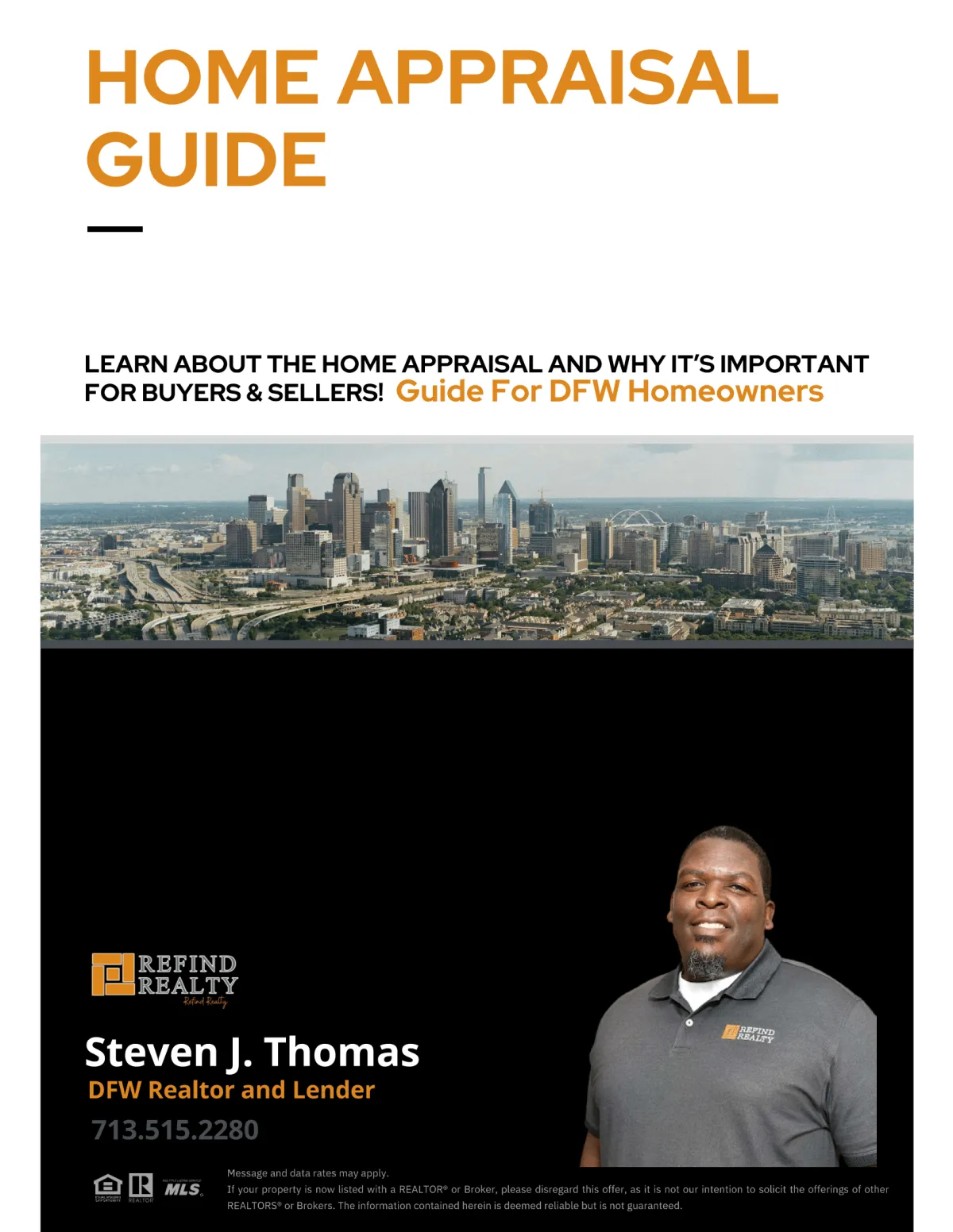You're Always At Home With Refind Realty.
Serving Your DFW Real Estate Needs Since 2005.
We Help You Buy and Sell in The Greater Dallas-Fort Worth Area.
Check Out Our Social Media Channels!
Buying in DFW
Buying your first or next home should be a rewarding and exciting time in your life, and one that you look back on with fond memories.
Thinking Of selling?
The market has changed a lot and I'd love to show you the exact strategy I use to get sellers in DFW top dollar for their property.
Get Pre-Approved
Let me walk you through the entire pre-approval process so you know exactly how much home you can afford.
Sign Up For my
Email List
My emails are a great way to stay up-to-date with local news and real estate market trends, even if you're not currently in the market. So, come on and join me to stay in the loop!
affordability Calculator
Get pre-approved to know exactly how much house you can afford. Use this calculator to get a quick estimate. Contact me for assistance!
DFW New Construction
Discover the latest new home constructions in DFW and take advantage of the builder incentives that are available now.


Owned and Operated by Thomas & Thomas Financial Group, LLC
Let's Make Your real estate Dreams Come True.
Newest Listings
Call Me Today At (713) 505-2280

Refind Realty Blog:


The Effect of Big Employers Moving to DFW on the Housing Market | Refind Realty DFW
The Effect of Big Employers Moving to DFW on the Housing Market
By Steven J. Thomas

Direct Answer
The wave of major employers relocating to Dallas–Fort Worth continues to reshape the local housing market — driving demand for both new construction and resale homes, especially in suburban cities south and north of Dallas.
From corporate giants like Goldman Sachs, Wells Fargo, Caterpillar, and Tesla to tech and logistics expansions across Plano, Fort Worth, and southern Dallas County, each move adds jobs, raises home values, and accelerates suburban development.
For homeowners, that means more buyer demand and equity growth — but also rising prices and competition for those planning to buy again.
1. The Corporate Migration Continues
Over the past decade, DFW has emerged as one of the nation’s top destinations for corporate relocations.
According to the Dallas Regional Chamber, more than 175 companies have relocated or expanded their headquarters here since 2010.
Recent moves include:
Goldman Sachs – new regional HQ in Downtown Dallas
Wells Fargo – $500M campus in Irving–Las Colinas
Caterpillar – global headquarters relocation from Illinois to Irving
Tesla & SpaceX expansions – supply chain growth across North Texas
PepsiCo & Samsung – new logistics and tech operations in southern suburbs
These relocations create high-paying jobs, demand for executive and workforce housing, and long-term stability in the market.
2. The Immediate Impact on Housing Demand
When major employers move in, housing demand spikes before the first employees even arrive. Builders, investors, and relocating buyers all react early.
Short-term effects:
Increased demand for rentals near corporate campuses.
Price growth in nearby suburban communities.
Higher absorption rates for new construction inventory.
Long-term effects:
Suburban infill development accelerates.
Infrastructure investments (schools, roads, retail).
Expanded property tax base stabilizing local markets.
In 2025, DFW’s population is projected to add 120,000+ residents, with housing starts already trailing population growth — a clear signal of sustained demand.
3. Where the Growth Is Concentrated
While relocations impact the entire metroplex, certain areas see stronger ripple effects:
RegionEmployer InfluenceReal Estate TrendIrving–Las ColinasWells Fargo, CaterpillarSurge in mid- to high-end housing and rental demandPlano–FriscoToyota, JPMorgan, Liberty MutualContinued upward pressure on resale pricingDowntown Dallas / UptownGoldman Sachs HQCondo and luxury rental growthSouthern Dallas Suburbs (DeSoto, Red Oak, Waxahachie)Industrial/logistics expansionNew construction boom with more affordable pricingFort Worth Alliance CorridorAmazon, Meta, Bell TextronIncreased new-home starts and land acquisition
📊 Explore active DFW new homes here: DFW New Construction Homes
4. The Builder Response
Builders are tracking corporate migration patterns closely — expanding south and west where land is still affordable.
Key builder trends in response:
Launching new master-planned communities near employment corridors.
Offering incentives tied to relocation buyers.
Partnering with relocation companies for quick-move-in inventory.
In southern Dallas County, builders like Bloomfield, Lennar, and Trophy Signature Homes are leading development around DeSoto, Red Oak, and Ferris — creating affordable options for employees priced out of Collin County.
5. What It Means for Homeowners
For current homeowners, big-employer relocations typically mean:
✅ Rising home values within a 10–15 mile radius of new corporate campuses.
✅ Stronger demand for turnkey, move-in ready homes.
✅ Faster sales cycles as relocation buyers often operate on tight timelines.
If you’ve owned your home for 3+ years, you’ve likely gained significant equity — positioning you to sell at a premium and move into a new build while inventory is still limited.
📈 Check your current equity position: Home Seller Score
6. What It Means for Buyers
While job growth drives opportunity, it also raises the bar for buyers.
Here’s how to stay ahead:
Get pre-approved early to lock in financing before competition rises.
Consider emerging suburbs like Forney, Midlothian, and DeSoto for better pricing and builder incentives.
Look at communities opening new phases ahead of demand spikes.
💰 Start your financing plan: Get Pre-Approved
7. What It Means for Investors
Investors benefit in both the short and long term.
Short-term: Increased rental demand and limited vacancy near new job hubs.
Long-term: Steady appreciation tied to population and infrastructure growth.
Single-family rentals and build-to-rent communities in suburbs south of Dallas and north of Fort Worth are performing especially well, with cap rates still favorable compared to Austin or Houston.
8. The Outlook for 2025–2026
The DFW housing market remains strong and resilient — driven by employment diversity, in-migration, and construction momentum.
Expect:
Home prices to rise 3–5% annually.
Continued suburban expansion.
Ongoing competition for quality resale and new construction homes.
The key takeaway: Jobs drive demand — and demand drives value.
Conclusion
As major employers continue moving to Dallas–Fort Worth, they’re bringing long-term stability and growth to the housing market.
For sellers, that means higher values and stronger buyer pools.
For buyers, it means acting early before the next wave of relocations pushes prices higher.
Whether you’re selling, upgrading, or investing, timing your move around DFW’s employment growth can make a measurable difference in your net outcome.
📈 Get Your Home Seller Score
🏡 Explore New Construction Homes
📅 Book a Home Goals Consultation
Key Takeaways
Big employers like Goldman Sachs, Wells Fargo, and Caterpillar are fueling DFW housing demand.
Suburbs near new job centers see faster appreciation and builder activity.
Homeowners gain equity, but buyers face increased competition.
Southern Dallas suburbs offer the best balance of affordability and growth potential.
Job growth will continue driving DFW’s housing strength through 2026.
Stay Informed With My Downloadable
Buyer and Seller guides

6 Smart Ways to Build Home Equity

7 Insider Secrets To Selling Your Home w/o a Lot of Time or Money

DFW Home Seller Negotiation Secrets

Home Appraisals Guide

Avoiding Pitfalls That Can Derail Your Home's Sale

Ultimate Guide To Buying a Home

A First Time Homebuyers Guide In DFW

Are You Ready To Buy?

25 Insider Secrets To Buying A Home

How to Improve Your Credit
Download All My Guides For Free


Owned and Operated by Thomas & Thomas Financial Group, LLC
Steven J. Thomas
Steven J. Thomas has been in the financial services industry for the past 19 years and started my career as a Financial Planner for American Express Financial Advisors. I entered into banking with JP Morgan Chase as personal banker in 2003 and was promoted several times up to Small Business Specialist. I earned multiple Million Dollar Club awards and was ranked in the top 5 Small Business Specialist before I branched out in 2005 to start my own Financial Management Company. I ran a successful company before family circumstances lead me to Wachovia Bank in 2008 where I worked as a Senior Financial Specialist. As a Sr. Financial Specialist; I was responsible for the P & L and revenue growth of my banking center. The elimination of my role thru a bank merger lead me to BBVA Compass. I have held various leadership roles at BBVA Compass including Personal Relationship Manager, Branch Retail Executive, Workplace Solutions VP, and his current role as a Retail Manager. As the Regional Workplace Solutions VP, I was responsible for the strategic, tactical, and execution of Partnership Banking relationships, promotion and activity with corporate and non-profit companies in my footprint. I was responsible for the acquisition production for three districts, which includes 51 banking centers and over 300 employees. In May of 2014, I joined the team at Refind Realty and became one of the managing partners in mid-2015.

Wondering What Your DFW Home Could Be Worth in 2025?
Get a Professional Home Valuation From A Local Market Expert
Unlock insights into potential selling prices.
Get a personalized analysis sent directly to your inbox.
Stay ahead with updates on property value fluctuations.
Benchmark your property against neighborhood listings.
Get a FREE Home Valuation And Potential Net Sheet:


I used this realtor and it was a great experience. He was patient and very helpful with our journey. He also helped us find a great lender with little hassle on the process, also got us approved for well above the market of our original home so we were able to get more house with a lower mortgage rate. So to anyone who is interested in buying a home take my advice give Steven a call. It’s worth it 😁
Bryant Loring


Steve was absolutely amazing! Everything was easy! Very professional in all aspects. Punctual, responsive, and diligent. He goes above and beyond to ensure you get to see as many homes as you’d like no matter the location. Not only was he knowledgeable about home buying, he also has a resourceful network for new home owner needs. I recommend Refind Realty to everyone!
Nicholas Bishop


I definitely recommend Steven to assist with your home buying needs. As a first time home buyer the process can be overwhelming, but as my realtor he was knowledgeable & patient while addressing my concerns and assisting me with my new home purchase. Thanks again Steven!! :-)
Gayle Mason

Ask Us Anything
Frequently Asked Questions
Why do you need a Realtor?
When buying or selling a home, there are so many options…which can also present a lot of obstacles. Laws change, forms change, and practices change all the time in the real estate industry. Because it’s our job to stay on top of those things, hiring a realtor reduces risk, and can also save you a lot of money in the long run.
When you work with me as your Realtor, you’re getting an expert who knows the area; knows how to skillfully guide your experience as a seller or buyer; can easily spot the difference between a good deal and a great deal. My job is to translate your dream into a real estate reality, and I work hard to earn and keep my business. This also means earning your trust: When you work with me, you’ll be working with a realtor who looks out for your best interests and is invested in your goals.
Which loan should you choose?
There are two different types of loans conventional loans and government-backed loans. The main difference is who insures these loans:
1 - Government-backed loans (FHA, VA and USDA):
(a) - Are, unsurprisingly, backed by the government.
(b) - Include FHA loans, VA loans, and USDA loans.
(c) - Make up less than 40 percent of the home loans generated in the U.S. each year.
2 - Conventional loans
(a) - Are not backed by the government.
(b) - Include conforming and non-conforming loans (such as jumbo loans).
(c) - Make up more than 60 percent of the loans generated in the U.S. each year.
What is the difference between FHA, VA and USDA loans?
1 - FHA LOANS:
FHA loans, which are insured by the Federal Housing Administration, are typically designed to meet the needs of first-time homebuyers with low or moderate incomes. FHA loans can be approved with a down payment of as little as 3.5 percent and a credit score as low as 580.
FHA loans are often called “helper loans,” because they give a leg up to potential borrowers who may not be able to secure one otherwise. For this reason, FHA loans have maximum lending limits, which are determined based on housing values for the county where the for-sale home is located.
Because the agency is taking on more risk by insuring FHA loans, the borrower is expected to pay mortgage insurance both at the time of closing and on a monthly basis, and the property must be owner-occupied.
2 - VA LOANS:
VA loans are backed by the Department of Veterans Affairs and they are guaranteed to qualified veterans and active-duty personnel and their spouses. VA loans can be approved with 100 percent financing, meaning VA borrowers are not required to make a down payment.
Unlike FHA loans, borrowers do not have to pay mortgage insurance on VA loans.
3 - USDA LOANS:
You may also hear about USDA loans, which are backed by the United States Department of Agriculture mortgage program. USDA loans are intended to support homeowners who purchase homes in rural and some suburban areas. USDA loans do not require a down payment and may offer lower interest rates; borrowers may have to pay a small mortgage insurance premium in order to offset the lender’s risk.
What’s a conventional loan? Understanding what it means to be conforming and non-conforming
Buyers who have a more established credit history and a larger down payment may prefer to apply for a conventional loan. These loans may offer a lower interest rate and only require the home buyer to purchase monthly mortgage insurance while the loan-to-value ratio is above a certain percentage, so a conventional loan borrower can typically save money in the long run.
Conventional loans are divided into two types: Conforming loans and non-conforming loans.
1 - CONFORMING LOANS:
Conforming loans are those that meet (or conform to) predetermined standards set by Fannie Mae and Freddie Mac — two government-sponsored institutions that buy and sell mortgages on the secondary market. By selling the loans to "Fannie and Freddie," lenders can free up their capital and return to issue more mortgages than if they had to personally back every loan that they approve.
The main standard for conforming loans is that the amount borrowed must be under a certain amount; in Alaska, a single-family home loan must be under $647,200 in order to be considered conforming.
Properties with more than one unit have higher limits.
2 - NON-CONFORMING (JUMBO) LOANS:
But what happens if a borrower wants to borrow more than the Freddie- and Fannie-approved loan amount? In this case, they would have to apply for a “jumbo loan,” which is the most common type of non-conforming loan.
Because the lender cannot resell the jumbo loan (or any non-conforming loan) to Freddie Mac or Fannie Mae, jumbo loans are considered to be riskier than a conforming loan. To protect against this risk, the bank will typically require a higher down payment; the interest rate on a jumbo loan may also be higher than if the same borrower applied for a conforming loan.
What kind of rate should you choose?
Rate types: Fixed-rate vs. adjustable-rate mortgages.
In addition to the loan type you choose, you’ll also have to determine if you want a fixed-rate mortgage or an adjustable-rate mortgage (ARM). A fixed-rate mortgage has an interest rate that does not change for the life of the loan, so it provides predictable monthly payments of principal and interest.
An adjustable-rate mortgage typically offers an initial introductory period with a low-interest rate. Once this period is over, the interest rate adjusts periodically, based on the market index. The initial interest rate on an ARM can sometimes be locked in for different periods, such as one, three, five, seven, or 10 years. Once the introductory period is over, the interest rate typically readjusts annually.
Office 1229 E. Pleasant Run Ste 224, DeSoto TX 75115
Call :(713) 505-2280
Email: [email protected]
Site: www.stevenjthomas.com

Facebook
Instagram
X
LinkedIn
Youtube
TikTok